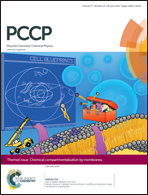Origin of the enhanced Li+ ionic conductivity in Gd+3 substituted Li5+2xLa3Nb2−xGdxO12 lithium conducting garnets
Abstract
In the present study, we report the synthesis and the Li+-ion conductivity of new Gd+3 substituted Li5+2xLa3Nb2−xGdxO12 (x = 0.0, 0.25, 0.4, 0.5, 0.6) garnets. The structural study by XRD showed that pure cubic garnet phases were obtained with upto x = 0.5 composition. With the further increase of the Gd+3 content to x ≥ 0.6, secondary phases are observed. The ionic conductivity was studied by impedance spectroscopy. We found that the Li+ ionic conductivity increased with increasing Gd+3 content with a maximum value of 1.12 × 10−4 S cm−1 at RT, which was two orders of magnitude larger than the previously reported value of 10−6 S cm−1 for pure Li5La3Nb2O12. A slight drop in the conductivity value to 6.25 × 10−5 S cm−1 was observed for x = 0.6 composition. By a systematic analysis of the conductivity spectra at different temperatures of the investigated materials, we are able to estimate the true values of the concentration, nc, and mobility, μ, of mobile Li+ that contribute to the conduction process; nc was found to increase by a factor of only ∼2 with increasing Gd+3 content from x = 0.0 to x = 0.5, whereas the mobility/diffusivity of Li+ increased considerably with increasing Gd+3 content. Therefore, the enhanced conductivity of the current materials is mainly due to the enhanced mobility of Li+. Surprisingly, the fraction of mobile Li+ represents only 3.44–6.96% of the total Li+ density of the materials.



 Please wait while we load your content...
Please wait while we load your content...